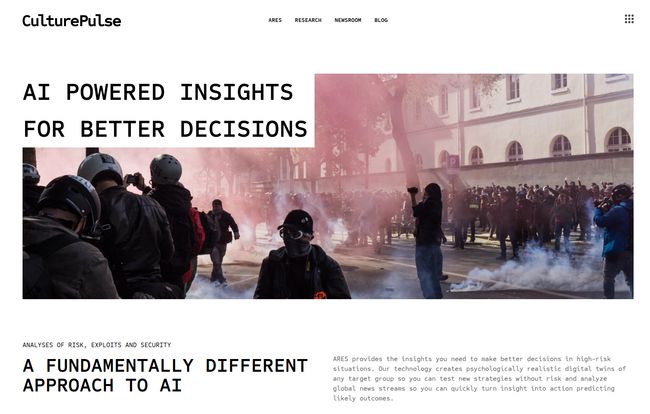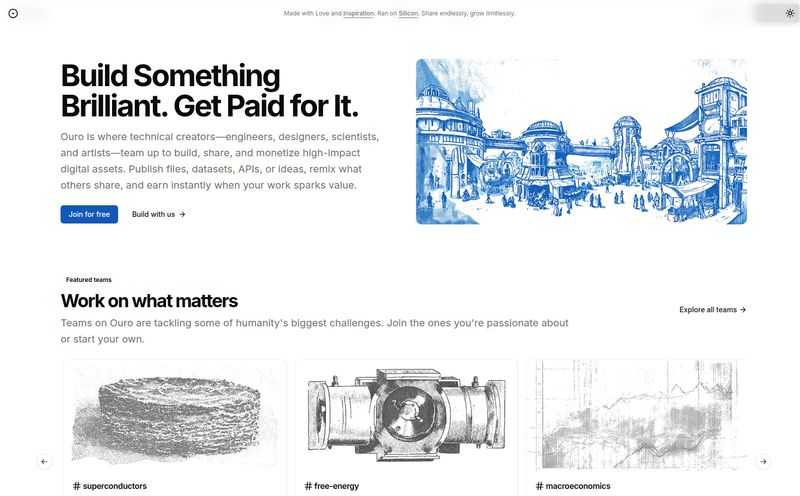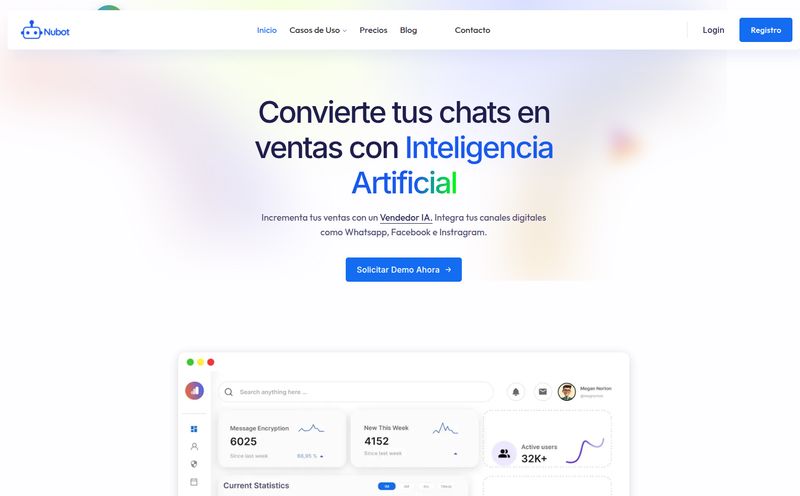As a performance marketer, I've burned more money on A/B testing ad creative than I’d care to admit on a first date. You craft two, maybe three, versions of an ad. You have a hunch about which one will work. You push them live, hold your breath, and pray to the gods of Google and Meta that your CPC doesn't go through the roof before you get a clear winner.
It's a necessary evil. Or… is it? For years, we've been told this is just the cost of doing business. The grind of optimizing campaigns. But what if you could run a hundred tests before spending a single dollar on traffic? What if you could test your messaging against a perfect replica of your audience, one that could tell you why it prefers one ad over another?
Sounds like something out of a sci-fi movie, right? That's what I thought too, until I stumbled across CulturePulse AI. And I have to say, my curiosity is officially piqued.
So, What on Earth is CulturePulse AI?
Strip away the jargon and the fancy website, and here’s the core idea: CulturePulse AI creates a digital twin of your target audience.
Think about that for a moment. It's not a lookalike audience based on a few shared interests. It’s a simulated population, an AI-driven focus group, built from what the company calls "psychologically realistic" models. This digital crowd is designed to think, feel, and react just like your real customers, based on their core values, beliefs, and cultural drivers.
The whole point is to let you test your ads, your messaging, your brand positioning on this virtual audience first. You throw your creative at these digital twins, and the platform spits back a “Resonance Score,” predicting how well your message will land in the real world. It’s like having a crystal ball for your marketing campaigns. A very, very nerdy crystal ball.

Visit CulturePulse
The Science Fiction Behind the Tech
Okay, I was skeptical. "Digital twins" sounds cool, but the ad tech space is littered with buzzwords that don't mean much. What caught my eye, though, was the background of CulturePulse. If you look at their site, you see research papers on things like modeling political extremism and the moral psychology of authoritarianism. Whoa. Heavy stuff.
This isn't your typical startup born in a garage in Silicon Valley with a mission to sell more drop-shipped widgets. It's rooted in some serious academic and sociological research. They're trying to model not just what people buy, but what they believe. And for a marketer, that’s the holy grail, isn't it? Connecting with people on a values level is how you build a brand, not just a customer list.
"CulturePulse technology helps me discover key insights in my research on COVID-19 Vaccine hesitancy. Working with the CulturePulse team has been a fantastic experience, opening up new possibilities for my scientific work."
When a tool is being used for scientific research on something as complex as vaccine hesitancy, it tells me it's operating on a different level than most of the ad tools I see pitched in my inbox every day.
How This Actually Helps Your ROAS
Alright, enough with the theory. How does this make you more money? The process is surprisingly straightforward for something so complex under the hood.
Step 1: Define Your Digital Audience
You don't just say "women aged 25-34 who like yoga." You go deeper. You can select from over 80 cultural categories and 50 psychological profiles. You're essentially building a model based on worldview, not just demographics.
Step 2: Test Your Creative Like Crazy
This is the fun part. Got five different headlines? Ten different images? Two different calls to action? Throw 'em all in. You can run massive multivariate tests without the cost and time of a real-world campaign. The platform simulates how your audience twin reacts to each combination and gives you predictive feedback on what will perform best.
Step 3: Get Insights, Not Just Data
Instead of just seeing that "Ad A beat Ad B," CulturePulse aims to tell you why. Maybe Ad A resonated better with your audience's sense of community, while Ad B felt too individualistic. This kind of insight is gold. It helps you not only pick the winning ad for this campaign but also get smarter for every future campaign. You stop guessing and start understanding the deep-seated motivations of your customers.
The Things I Genuinely Like
After digging in, a few things really stand out. First, the potential for cost and time savings is massive. The budget I’ve historically set aside for creative testing could be drastically reduced or, better yet, reallocated to scaling the winning ads this tool helps identify. That alone is a huge win.
Second, I love the emphasis on global reach. The platform supports over 100 languages. As someone who has managed international campaigns, I can tell you that simply translating an ad is not enough. Culture is way more than language. A message that works in Texas might completely flop in Tokyo. The ability to test against different cultural models is, frankly, incredible.
Finally, it pushes us marketers to be better. To think beyond the click and the conversion and consider the human being on the other side of the screen. What do they value? What do they believe in? Aligning with that is how you get a 2-3x ROAS, which is the bold claim they make.
A Healthy Dose of Skepticism: The Reality Check
Now, it can't all be sunshine and soaring conversion rates. I have my reservations. My biggest question is about the fidelity of the digital twins. Can an AI model, no matter how sophisticated, truly capture the messy, irrational, beautiful chaos of human decision-making? I'm not 100% convinced. It's a powerful simulation, but it's still a simulation.
There's also the ever-present issue of AI bias. The models are only as good as the data they're trained on. If there's inherent bias in the source data, that bias will be reflected in the digital twins, potentially leading you down the wrong path. It requires a level of trust in their methodology.
And let's be honest, this isn't a tool for a complete beginner. To get the most out of it, you need to have a decent grasp of marketing psychology and be willing to think in terms of these cultural and psychological categories. It's not a simple 'push button, get sales' machine. It requires a thoughtful operator.
Let's Talk Money: CulturePulse AI Pricing
So what's the damage? The pricing structure is actually quite accessible, which surprised me. They seem to want people to try it out, which is a good sign.
| Plan | Price | Key Features |
|---|---|---|
| Basic | Free | 1 user, up to 10 A/B tests/month, limited audience access |
| Premium | $49 / month | 1 user, up to 500 A/B tests/month, unlimited audience access, detailed analysis |
| Enterprise | Let's Talk (Custom) | Unlimited users, custom audiences, dedicated support |
The free plan is more than enough to get your feet wet and see if the concept works for you. And they’re currently running a promo: use the code FREE30 to get 30 days of the Premium plan for free. That’s a pretty generous offer and a no-brainer if you're curious.
Who Is This Really For?
I don't think CulturePulse is for the solo entrepreneur running a local pizza shop. But for mid-to-large size businesses, marketing agencies managing multiple clients, or any organization running significant ad spend, the potential ROI is obvious. I also see a massive application for non-profits, political campaigns, and public health initiatives—anywhere that deeply resonant messaging is critical.
Frequently Asked Questions
How does CulturePulse AI actually work?
It uses sophisticated AI to create "digital twins"—simulated versions of your target audience. You can then test your ad creatives against these twins to predict which messages will resonate best with real people, all before you spend money on a live campaign.
Is CulturePulse AI better than traditional A/B testing?
It's different. It's designed to be a preliminary step that makes your traditional A/B testing more effective. You can test hundreds of variations quickly and cheaply in the simulation, identify the top 2-3 contenders, and then use your ad budget to run a much more focused, effective A/B test in the real world.
Can it really predict what my customers will do?
It provides a prediction, not a guarantee. The platform is based on peer-reviewed academic research and aims for high predictive accuracy. The goal is to dramatically increase your odds of success and reduce wasted ad spend by eliminating the clear losers before they ever see the light of day.
What kind of data does it analyze to build the twins?
It focuses on deep-seated values, beliefs, and psychological drivers rather than just surface-level interests. It uses models based on over 50 psychological and 80 cultural categories to build a holistic view of an audience.
Is there a free trial?
Yes, there's a permanent 'Basic' free plan. Plus, you can use the code FREE30 to get a 30-day free trial of their more powerful Premium plan, which is what I’d suggest to really get a feel for its capabilities.
What if my audience is in a very specific niche?
This is where the Enterprise plan likely comes in. While the Premium plan offers access to many audience types, highly specific or unusual niches might require a custom-built digital twin, which is a service they offer for larger clients.
Final Thoughts: A Glimpse of the Future?
CulturePulse AI is one of the most interesting tools I've seen in a long time. It feels like a genuine step forward. We're moving from an era of brute-force testing to one of intelligent simulation. It's not perfect, and it doesn't replace the need for smart marketing intuition, but it augments it in a powerful way.
Will I be using it? I'm already signed up for the trial. The potential to save money and gain a deeper understanding of my audience is just too compelling to ignore. It might just be the edge we've all been looking for in an increasingly crowded digital ad space.
Reference and Sources
- CulturePulse AI Official Website: https://culturepulse.ai/



